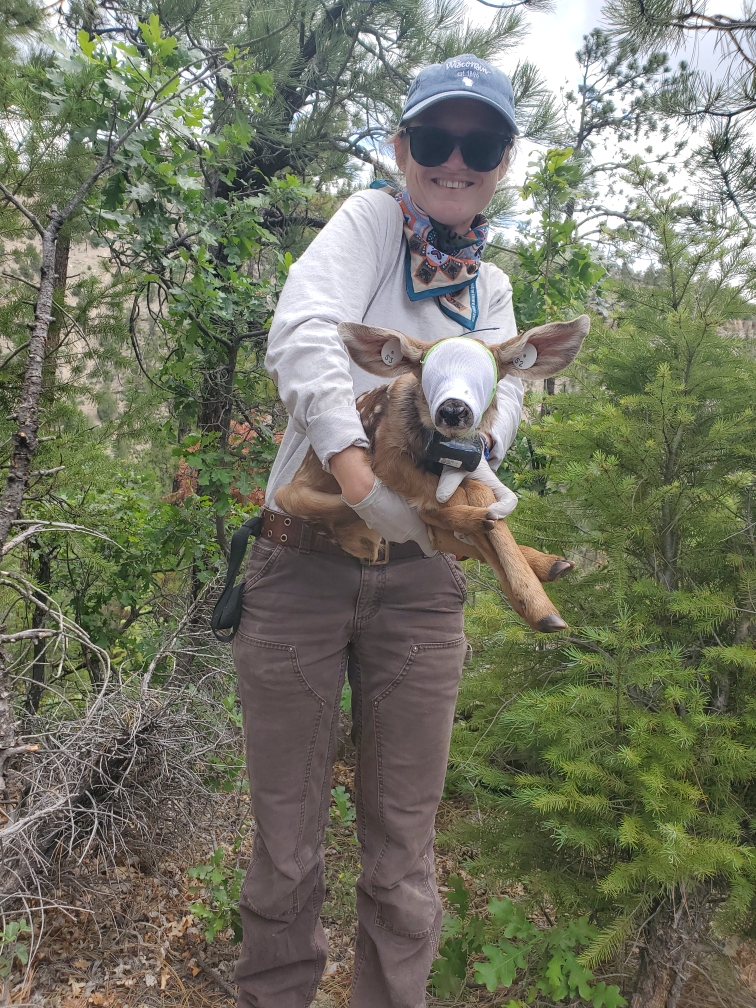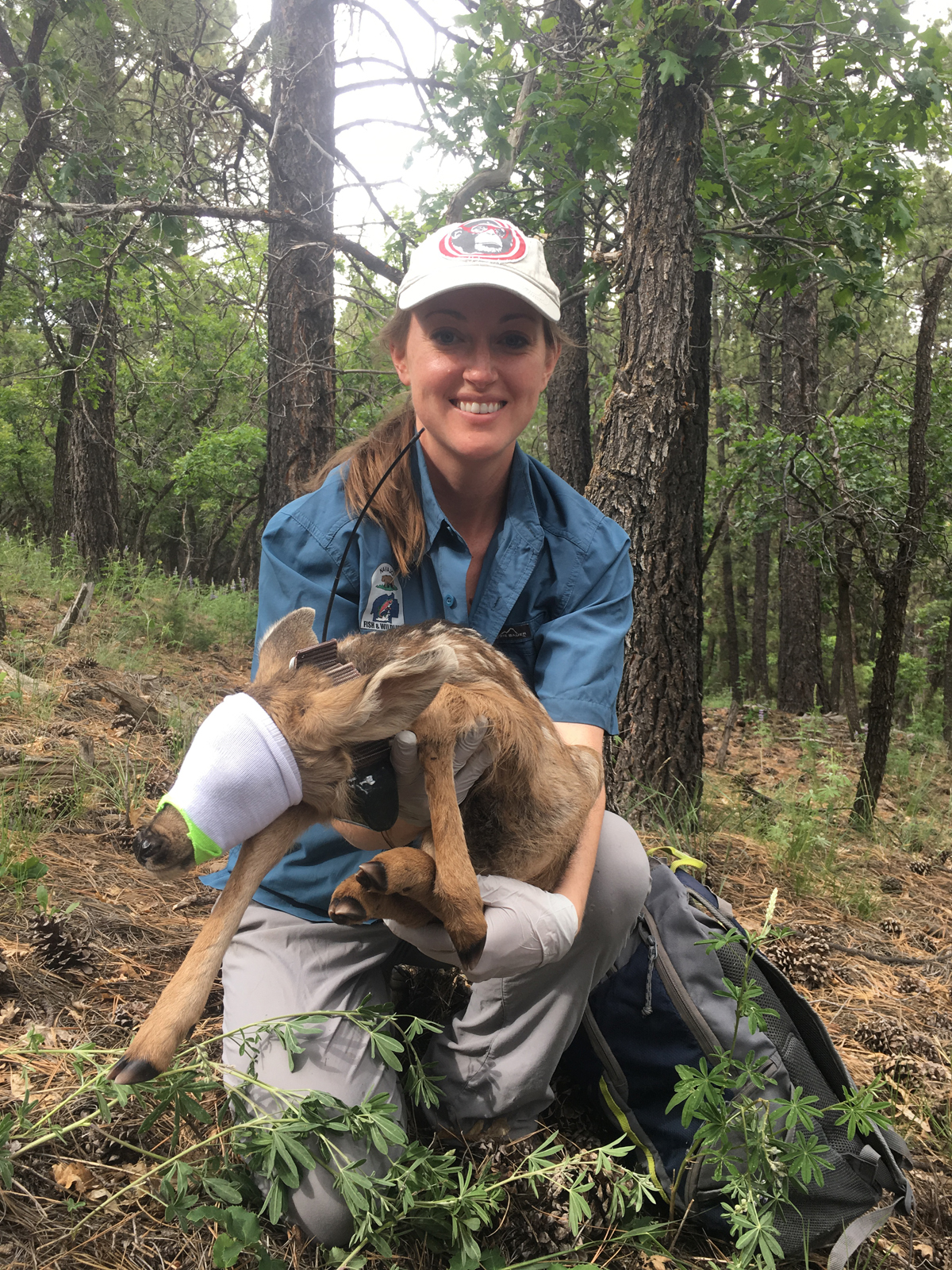
Hannah Manninen, a master’s student in forestry at Southern Illinois University Carbondale, holds a mule deer fawn captured briefly for tracking purposes. A graduate student at SIU, Manninen is working with the Navajo Nation to unlock secrets of the mule deer migration to identify key habitats and arrest the species decline.
April 13, 2021
SIU forestry student tracks mule deer routes to protect habitats
CARBONDALE, Ill. — A graduate student at Southern Illinois University Carbondale is working with a western Native American tribe to unlock secrets of the mule deer migration to identify key habitat and arrest the species decline.
Hannah Manninen, a master’s student in forestry at SIU, is nearing the end of her work on the species, using location data from mule deer captured by the Navajo Nation and fitted with GPS collars.
“The aim of the project is to determine migration routes for mule deer populations on the Navajo Nation, as well as determine the start and end dates for migrations,” Manninen said. “Looking at the home ranges and seasonal ranges of GPS-collared individuals will help us to determine what habitat is being most used by mule deer. From our findings, we will be able to prioritize specific habitat and protect areas commonly used.”
An important species in decline
Mule deer populations have been declining across the western United States for decades, with the decline being even more pronounced on the Navajo Nation, Manninen said. Scientists lay the blame on several factors, including habitat loss, overgrazing by livestock, disease and predation.
“Declines are a cause of concern because mule deer are economically and traditionally important and can cause loss of hunting opportunities and revenue to the Navajo Nation, as well as other management agencies,” Manninen said.
A varied approach
Manninen began working on the project in January 2019 and hopes to wrap it up by this August. She is advised by Clay Nielsen, professor in SIU’s Forestry Program and Cooperative Wildlife Research Laboratory.
The work first took Manninen into the field, living on the Navajo Nation while searching for fawns to collar during birthing season. She also would visit sites where mule deer were found deceased to determine the cause of death.
The area in question remains quite wild, as trail cameras set up at the sites of such mortalities captured images of mountain lions and bears returning to feed.
Gathering data
Additional collaring rounds using helicopters to capture mule deer on the Navajo Nation; capture and collaring activities were conducted by biologists with the Navajo Nation Department of Fish and Wildlife. In all, the researchers managed to collar and track 99 mule deer.
“All the mule deer we captured and collared have GPS collars, so I was able to switch gears in August of 2019 and work remotely from my computer in Carbondale,” she said. “With the collars, I’m able to receive the mule deer locations information anywhere that I have an internet connection.”
Working on research in the field was a thrill on many levels.
“The area we were working is absolutely stunning,” Manninen said. “I was very happy to be able to spend at least one field season there capturing and tracking fawns.”
Another SIU tie to the project is Jess Fort, who earned her master’s degree at SIU working with Nielsen. She is now a wildlife biologist for the Navajo Nation and is collaborating on the project.
“She’s another SIU grad who’s gone on to do good things,” Nielsen said.
Seeing it through
Manninen has worked in the field before this project, but she said this project is special because she will be in on it from start to finish. It will be her first time taking the information from the field work running the analysis that will actually guide conservation efforts for the important species.
“I’m especially excited because I am able to see the project through in its entirety,” she said. “I’m very invested in each aspect of the project since my final results will depend on it. And I’ve learned that I enjoy the analysis aspect and would like to continue this work into the future.”
SIU opens doors
Nielsen said the work Manninen is doing is important because it will provide answers to an ongoing conservation problem.
“Even in the vast American West, habitat protection is a major concern for several wildlife species, Nielsen said. “Our research will provide critical information toward this goal while extending SIU's reach as a strong collaborator with natural resource management agencies across the globe.”
Manninen said Nielsen’s expertise and guidance is invaluable to her efforts.
“He made the whole project possible,” Manninen said, “He is always available to answer my questions and he makes sure my research is continuously headed in the right direction.”
Guillaume Bastille-Rousseau, an assistant professor with SIU’s Cooperative Wildlife Research Laboratory, also is helping Manninen with the project. He is an ecologist specializing in understanding the drivers of species movement, habitat selection and how such factors interact among species living certain geographic regions on larger scales.
Having the synergy of wildlife professionals and students involved with the CWRL is a big advantage, Manninen said.
“The SIU Cooperative Wildlife Research Lab has a cohort of students, including my lab, which have been very helpful with any questions about school and research life,” she said.
The future…
Manninen hopes to use the skills she’s developing to forge a career as a research scientist after graduation.
“Whether that be for a federal, state or nonprofit organization, that is my hope for the future,” she said. “In my ideal world, I would like to lead projects, while also being able to go in the field periodically.”

